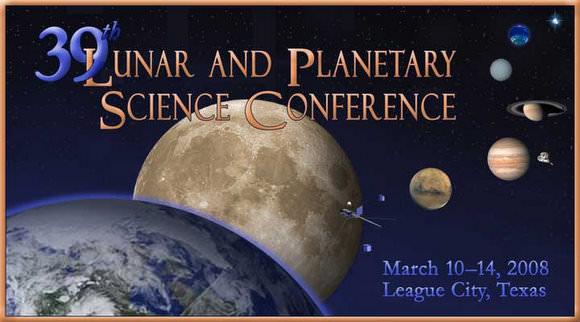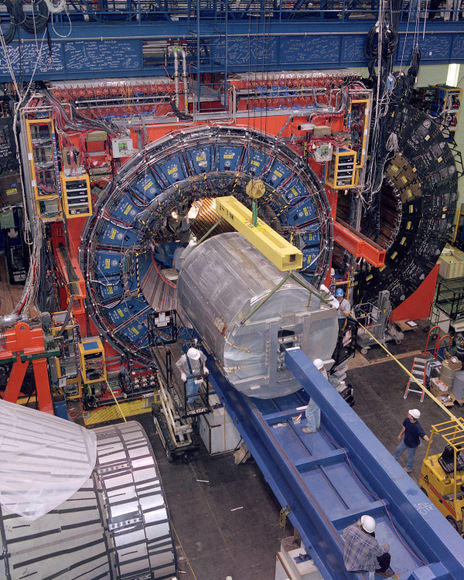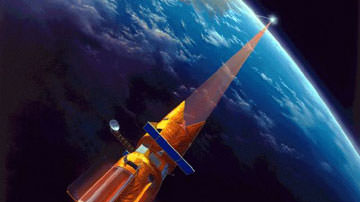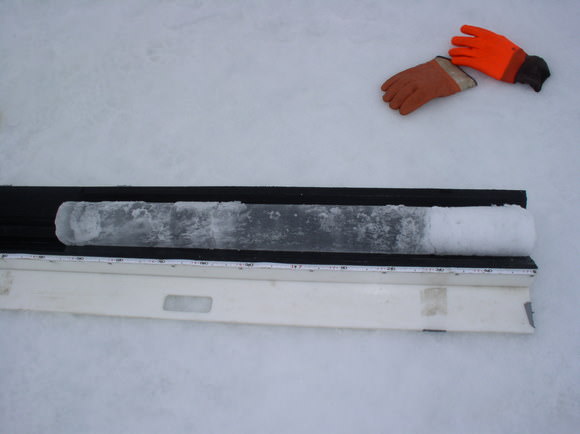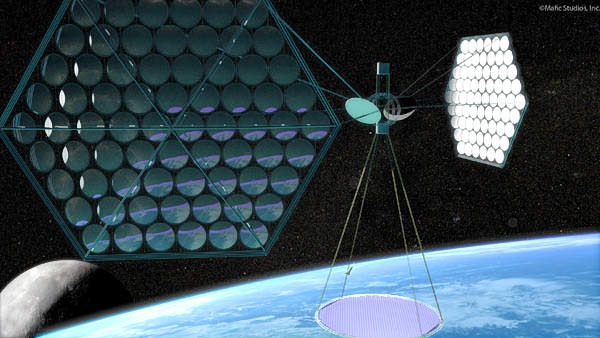Dr. Pamela Gay from Astronomy Cast is attending the Lunar and Planetary Science Conference this week and is blogging from the conference. You can catch her updates at Astronomy Cast Live . She’s already posted some very interesting reports on how the Martian north pole region — where the Phoenix lander sits — may currently be habitable, and the debate on how planets should be classified. Great stuff — check it out!
Disappearing Stars Confirm Supernova Origins
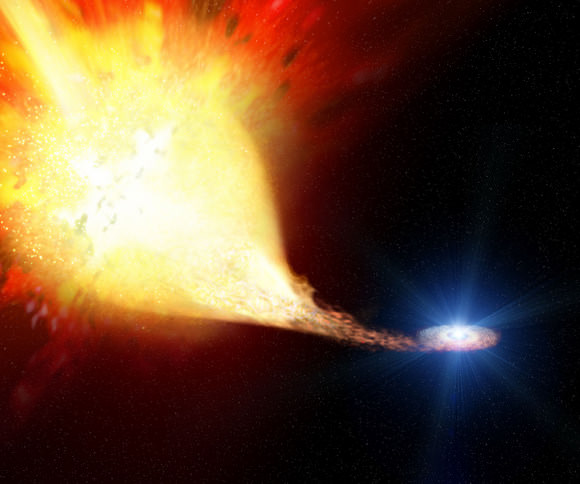
Artist’s rendering of SN 1993J, where a red supergiant supernova progenitor star (left) is exploding after having transferred about seven solar masses of hydrogen gas to the blue companion star (right). Credit: ESA
Astronomers have caught two stars in the disappearing acts that link them to type II supernova events.
Type II supernovae are widely believed to result from the internal collapse and explosion of massive stars, about nine times the size of our sun. But precious few observations have actually confirmed the relationship.
Now, researchers have spotted two parent stars that showed up in supernovae “before” images — but not in images taken after the blasts.
“The disappearance of the progenitors confirms that these two supernovae were produced by Red Supergiants,” write co-authors Justyn Maund and Stephen Smartt. Their new paper is out in this week’s issue of Science.
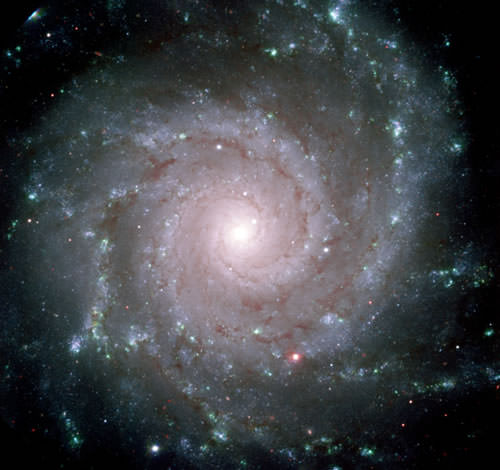
So far only one star has been shown to have disappeared after it exploded — the star that exploded as SN 1987A in the Local Group of galaxies. Seven other stars have been spotted in the neighborhoods of type II supernovae before they went off, but none of them has been shown to have disappeared, Maund and Smartt write.
Maund is affiliated with both the University of Copenhagen in Denmark and the University of California at Santa Cruz, and Smartt is from Queen’s University Belfast in the UK. They used the Hubble Space Telescope and the Gemini Telescope to observe the two supernovae.
The progenitor of SN 2003gd, an M-supergiant star in the galaxy M74, “is no longer observed at the SN location,” they found. They estimated 2003gd is seven times the mass of the sun, which they acknowledge “is at the lower end of the mass range considered theoretically possible to produce core-collapse events.” They said there’s enough uncertainty in the object’s mass that it could be greater than seven solar masses — but even if it’s not, several other stars in the low end of the range are suspected of exploding as supernovae.
The co-authors are also careful to point out that dust from the supernova is still visible, and, “One could argue that the star identified as the progenitor was a neighboring star that is now obscured by dust formation.” But their work indicates that the explosion wasn’t dusty enough to obscure a star as luminous as SN 2003gd’s parent. They believe the progenitor star has truly disappeared — although further confirmation will come as the dust continues to clear.
SN 1993J is a truly exceptional case. The K-supergiant star that exploded in that supernova is also no longer present, the authors report — but its B-supergiant binary companion is still observed.
The model for the binary system was of a progenitor star 15 times the mass of the sun, with a slightly less massive binary companion. The progenitor star evolved faster, and transferred some of its mass onto the binary companion, including a substantial amount of its hydrogen envelope. The binary companion grew to 22 times the mass of the sun. The interaction happened over about 250 years and affected the supernova explosion to such an extent that SN 1993J became known as one of the most peculiar supernovae ever seen.
The site of SN 1993J was imaged several times over the 2 to 13 years after the explosion with Hubble and a handful of other telescopes. By the 2004 observation, the red portion of the SN spectral energy distribution had faded below the level of the red spectral energy of the binary progenitor system, “ruling out the continued presence of the K-supergiant star and, hence, confirming it as the progenitor of SN 1993J,” the authors wrote.
They said soon the blue part of the supernova’s spectrum will fade, opening up a window for observations of the remaining companion star.
The authors conclude that their “simple, but time-consuming” method “leaves no doubt that the two stars were the progenitors of the supernovas, SN 2003gd and SN 1993J, and confirms that type II supernovas are birthed from Red Supergiants, as predicted.”
New Particle Throws Monkeywrench in Particle Physics
[/caption]
The hits just keep on coming from Department of Energy’s Fermi National Accelerator Laboratory. So far this month, the lab has announced the discovery of a rare single top quark, and then narrowed the gap — twice, actually — for the mass of the elusive Higgs Boson particle, or “God particle,” thought to give all other particles their mass.
Now, scientists have detected a new, completely untheorized particle that challenges what physicists thought they knew about how quarks combine to form matter. They’re calling it Y(4140), reflecting its measured mass of 4140 Mega-electron volts.
“It must be trying to tell us something,” said Jacobo Konigsberg of the University of Florida, a spokesman for Fermilab’s collider detector team. “So far, we’re not sure what that is, but rest assured we’ll keep on listening.”

Matter as we know it comprises building blocks called quarks. Quarks fit together in various well-established ways to build other particles: mesons, made of a quark-antiquark pair, and baryons, made of three quarks.
But recently, electron-positron colliders at Stanford’s SLAC National Accelerator Laboratory and the Japanese laboratory KEK have revealed examples of composite quark structures — named X and Y particles — that are not the usual mesons and baryons. And now, the Collider Detector at Fermilab (CDF) collaboration has found evidence for the Y(4140) particle.
The Y(4140) particle decays into a pair of other particles, the J/psi and the phi, suggesting to physicists that it might be a composition of charm and anticharm quarks. However, the characteristics of this decay do not fit the conventional expectations for such a make-up. Other possible interpretations beyond a simple quark-antiquark structure are hybrid particles that also contain gluons, or even four-quark combinations.
The Fermilab scientists observed Y(4140) particles in the decay of a much more commonly produced particle containing a bottom quark, called the B+ meson. Sifting through trillions of proton-antiproton collisions from Fermilab’s Tevatron, they identified a small sampling of B+ mesons that decayed in an unexpected pattern. Further analysis showed that the B+ mesons were decaying into Y(4140).
The Y(4140) particle is the newest member of a family of particles of similar unusual characteristics observed in the last several years by experimenters at Fermilab’s Tevatron as well as at KEK and the SLAC lab, which operates at Stanford through a partnership with the U.S. Department of Energy.
“We congratulate CDF on the first evidence for a new unexpected Y state that decays to J/psi and phi,” said Japanese physicist Masanori Yamauchi, a KEK spokesperson. “This state may be related to the Y(3940) state discovered by Belle and might be another example of an exotic hadron containing charm quarks. We will try to confirm this state in our own Belle data.”
Theoretical physicists are trying to decode the true nature of these exotic combinations of quarks that fall outside our current understanding of mesons and baryons. Meanwhile, experimentalists happily continue to search for more such particles.
“We’re building upon our knowledge piece by piece,” said Fermilab spokesperson Rob Roser, “and with enough pieces, we’ll understand how this puzzle fits together.”
The Y(4140) observation is the subject of an article submitted by CDF to Physical Review Letters this week. Besides announcing Y(4140), the CDF experiment collaboration is presenting more than 40 new results at the Moriond Conference on Quantum Chromodynamics in Europe this week, including the discovery of electroweak top-quark production and a new limit on the Higgs boson, in concert with experimenters from Fermilab’s DZero collaboration.
Source: Fermilab
Rocket Scientists Use ‘Star Wars’ Technology to Fight Mosquitoes
[/caption]
Mosquitoes are a hardy, resilient sort; these insect have been around for thousands of years and recently, one mosquito even survived a stint in space. Mosquitoes aren’t just an annoyance, but they also carry deadly diseases. Now, humans may have a new defense against mosquitoes and the diseases they carry, like malaria. Laser technology developed for the Cold War missile defense system called the Strategic Defense Initiative (also known as Star Wars) is now being retooled to for the fight against mosquitoes. The laser system is intelligent enough that humans and butterflies aren’t affected by the beams, but it zaps mosquitoes flat. It can even tell the difference between female mosquitoes, the blood-drinkers, and males. “We like to think back then we made some contribution to the ending of the Cold War” with the Star Wars program, said Dr. Jordin Kare. “Now we’re just trying to make a dent in a war that’s actually gone on a lot longer and claimed a lot more lives.”
The original use of the lasers would shield the US against the Soviet nuclear arms. Its rebirth as a bug killer came from Nathan Myhrvold, a former Microsoft Corp. executive who now runs Intellectual Ventures LLC., a company that collects patents and funds inventions. His old boss, Bill Gates, had asked him to explore new ways of combating malaria. At a brainstorming session in 2007, Dr. Lowell Wood, an astrophysicist who helped develop the Star Wars technology, suggested using lasers on mosquitoes.
The scientists envision their technology might one day be used to draw a laser barrier around a house or village that could kill or blind the bugs. Or, laser-equipped drone aircraft could track bugs by radar, sweeping the sky with death-dealing photons.

They now face one big challenge: deciding how strong to make the weapon. The laser has to be weak enough to not harm humans and smart enough to avoid hitting useful bugs. “You could kill billions of mosquitoes a night, and you could do so without harming butterflies,” says Myhrvold.
During a recent demonstration, the researchers were able to locate mosquitoes in an old 10-gallon fish tank using a camera with a zoom lens which fed the visual data into a computer which controls the laser and aims the beam at the bugs. When hit, the mosquitoes burst into flame. Each time a beam strikes a bug, the computer makes a gunshot sound to signal a direct hit.
Not only can the laser target a mosquito, it can also tell a male from a female based on wing-beat. That’s a crucial distinction, since only females feed on blood and thus transmit disease.
“If you really were a purist, you could only kill the females, not the males,” Myhrvold sad. But since they’re mosquitoes, he says, he’ll probably “just slay them all.”
Other scientists have worked on ways to eradicate mosquitoes with microwaves, or genetically altering the insects to build a version that is malaria free. Another researcher is looking for a way to make mosquitoes as a force for good, by transforming them into “flying syringes” that deliver vaccines each time they bite.
Source: Wall Street Journal
Why is Science Important?
Science is everywhere in today’s world. It is part of our daily lives, from cooking and gardening, to recycling and comprehending the daily weather report, to reading a map and using a computer. Advances in technology and science are transforming our world at an incredible pace, and our children’s future will surely be filled with leaps in technology we can only imagine. Being “science literate” will no longer be just an advantage but an absolute necessity. We can’t escape from the significance of science in our world.
But not everyone understands that, or has been taught to think critically, or been provided with the tools to analyze and test a problem or situation.
Alom Shaha is a school teacher in the UK, and he has put together a website and a video, asking people to share why science is important. There are scientists, educators, psychologists, artists and many others from different walks of life who participated in this project. The video is of exceptional quality, and I urge everyone to watch and share it. Help people learn about the importance of science.
Why is Science Important? from Alom Shaha on Vimeo.
Evidence of Supernovae Found in Ice Core Sample
[/caption]
Chinese and Arabic astronomers left historical documentation of a supernova that occurred in our own galaxy in the year 1006 (SN 1006), and another one 48 years later (SN 1054). Some of the writings about SN 1006 say there was a visual explosion half the size of the moon, and it shone so brightly that objects on the ground could be seen at night. We know these writings weren’t just fantastical imaginations because we now have the “leftovers” of these supernovae; Supernova Remnant 1006 and the Crab Nebula. But now there is more evidence. A team of Japanese scientists has found the first evidence of supernovae in an ice core sample.
The gamma rays from nearby supernova ought to have a significant impact on our atmosphere, in particular by producing an excess of nitrogen oxide. Ice cores are known to be rich in information regarding past climates, and scientists thought core samples could record astronomical phenomena, as well. In 1979, a group of researchers suggested the idea when they found nitrate ion (NO3-) concentration spikes in an ice core sample from the South Pole ice core that might correlate with the known historical supernovae Tycho (AD 1572), Kepler (AD 1604), and SN 1181 (AD 1181). Their findings, however, were not supported by subsequent examinations by other researchers using different ice cores, and the results remained controversial and confusing.
But in 2001, a team of scientists from Japan drilled a 122 meter ice core sample at the Dome Fuji station in Antarctica, an inland site in Antarctica. At a depth of about 50 metres, corresponding to the 11th century, they found three nitrogen oxide spikes, two of which were 48 years apart and easily identifiable as belonging to SN 1006 and SN 1054. The team speculates that the mysterious third spike may have been caused by another supernova, visible only from the southern hemisphere.

Additionally, the team saw a 10 year variation in the background levels of nitrogen oxide, almost certainly caused by the 11-year solar cycle, an effect that has been seen before in ice cores. This is one of the first times that a distinct 11-year solar cycle has been observed for a period before the landmark studies of sunspots by Galileo Galilei with his telescope.
They also saw a number of sulphate spikes from known volcanic eruptions such as Taupo, New Zealand, in 180 AD and El Chichon, Mexico, in 1260 AD.
The team said that by further extending their analysis to deeper and shallower ice cores would give fruitful information on galactic supernova and solar activity histories, and they are now in the process of making ionic measurements covering the past 2,000 years, including analyses of all known historical supernovae and solar periods.
Sources: arXiv, arXiv Blog
UFOs or High Altitude Lightning?
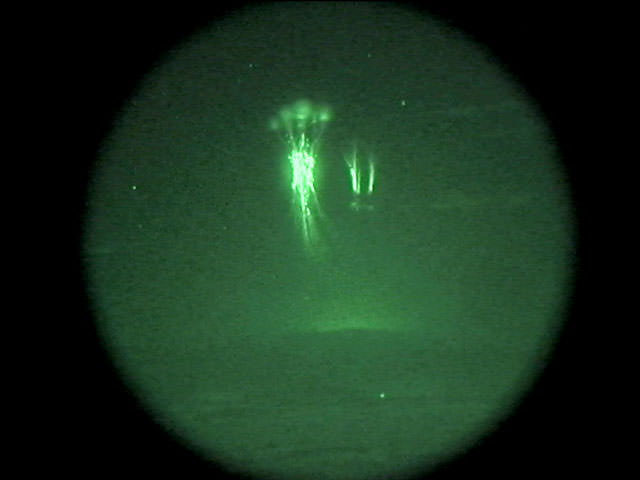
[/caption]
Over 90% of UFO sightings can be easily explained, and are usually visual misinterpretations of meteors, weather balloons, a flock of birds, blimps, or even the Moon. Here’s one more to add to the list of items mistakenly identified as UFO’s: sprites. No, not the elf or troll-like sprites, but a natural phenomenon which occurs during thunderstorms. “Sprites appear above most thunderstorms,” said Colin Price of the Tel Aviv University, “but we didn’t see them until recently. They are high in the sky and last for only a fraction of a second.” While there is much debate over the cause or function of these mysterious flashes in the sky, Price says they may explain some bizarre reports of UFO sightings.
Sprites are described as flashes high in the atmosphere, between 35 and 80 miles from the ground, much higher than the 7 to 10 miles where regular lightning bolts usually occur.
“Lightning from the thunderstorm excites the electric field above, producing a flash of light called a sprite,” explained Price, head of the Geophysics and Planetary Sciences Department at Tel Aviv University. “We now understand that only a specific type of lightning is the trigger that initiates sprites aloft.”
![]()
Though sprites have existed for millions of years, they were first discovered and documented only by accident in 1989 when a researcher studying stars was calibrating a camera pointed at the distant atmosphere where sprites occur.
“Sprites, which only occur in conjunction with thunderstorms, never occur on their own, and are cousins to similar natural phenomenon dubbed by atmospheric electricians as ‘elves,’ ‘goblins’ and ‘trolls,'” said Price. These flashes are so named because they appear to “dance” in the sky, which may explain some UFO sightings.
Price and has led students and other researchers in studying sprites for several years, and Tel Aviv University has been one of the leaders in researching the phenomenon. Now, Price and his students are teaming up with students from The Open University and The Hebrew University to take three-dimensional pictures of sprites to gain a better understanding of their structure. Using remote-controlled roof-mounted cameras, the researchers are able to look at the thunderstorms that produce sprites when they are still over the Mediterranean Sea.
Using new camera techniques has revealed the sprites’ circular structures, which are much like those of candles on a birthday cake. Using triangulation, Price and his team have also been able to calculate the dimensions of the sprites’ features. “The candles in the sprites are up to 15 miles high, with the cluster of candles 45 miles wide — it looks like a huge birthday celebration!”
Because of their high altitude, sprites may also have an impact on the chemistry of the Earth’s ozone layer. “Since they are relatively infrequent, the global impact is likely small,” said Price. “But we’re researching that now.”
Source: PhysOrg
Sweet Potatoes Flew into Space Aboard Columbia

[/caption]
A team of researchers from the Deep South sent sweet potato plants into space, as part of an experiment aimed at providing food for long-term space missions.
Desmond G. Mortley, from the G.W. Carver Agricultural Experiment Station at Alabama’s Tuskegee University, and his colleagues launched the sweet potato cuttings on a five-day mission aboard the space shuttle Columbia, and compared their success to ground-based cuttings at Kennedy Space Center in Florida.
“The intent of the experiment was to study if stem cuttings would be a successful means of propagating plants in space, just as they are on Earth,” said Raymond Wheeler, a study co-author from NASA’s Biological Science Office at the Kennedy Space Center. “The results showed that the cuttings did indeed produce adventitious roots in microgravity, suggesting that cuttings should work well in space settings.”
The sweet potato experiment was flown on Columbia’s July 1999 mission to the Chandra X-Ray Observatory. The study findings were published in the May 2008 issue of the Journal of American Society for Horticultural Science, although a public press release was issued just this week.
Seeds of several crops have been grown in microgravity, but this was the first test for plants grown from cuttings. Cuttings grow roots faster than seeds do, and sweet potato cuttings regenerate very easily. This made them ideal for the study.
According to the study authors, all of the cuttings produced roots and growth was “quite vigorous in both ground-based and flight samples.” Except for a slight browning of some root tips in the flight samples, all of the stem cuttings appeared normal, they added. The roots on the flight cuttings tended to grow in random directions, sometimes perpendicular to the stems. Also, stem cuttings grown in microgravity had more roots and longer roots than ground-based controls.
The next step, Mortley and his colleagues say, will be to experiment over longer space missions to test root cuttings’ ability to grow plants.
Source: Eurekalert and Journal of American Society for Horticultural Science.
New Company Looks to Produce Space Based Solar Power Within a Decade
[/caption]
Is space-based solar power (SBSP) a technology whose time has come? The concept and even some of the hardware for harnessing energy from the sun with orbiting solar arrays has been around for some time. But the biggest challenge for making the concept a reality, says entrepreneur Peter Sage of Space Energy, Inc., is that SBSP has never been commercially viable. But that could be changing. Space Energy, Inc. has assembled an impressive team of scientists, engineers and business people, putting together what Sage calls “a rock-solid commercial platform” for their company. And given the current looming issues of growing energy needs and climate change, Space Energy, Inc. could be in the right place at the right time.
“Although it’s a very grandiose vision, it makes total sense,” Sage told Universe Today. “This is an inevitable technology; it’s going to happen. If we can put solar panels in space where the sun shines 24 hours a day, if we have a safe way of transmitting the energy to Earth and broadcasting it anywhere, that is a serious game changer.” If everything falls into place for this company, they could be producing commercially available SBSP within a decade.
The basic concept of SBSP is having solar cells in space collecting energy from sun, then converting the energy into a low intensity microwave beam, sending it down to Earth where it is collected on a rectenna, and then fed into the power grid to provide electricity. Almost 200 million gigawatts of solar energy is beamed towards the Earth every second, which is more energy than our civilization has used since the dawn of the electrical age. We only need a way to harness that energy and make it usable.
Space Energy, Inc.’s vision is to help create an energy-independent world, and improve the lives of millions of people by bringing a source of safe, clean energy to the planet from space. They are looking to become the world’s leading, and perhaps the first, SBSP enterprise.
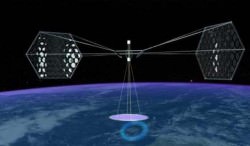
“The biggest challenge for SBSP is making it work on a commercial level in terms of bottom line,” said Sage, “i.e., putting together a business case that would allow the enormous infrastructure costs to be raised, the plan implemented, and then electricity sold at a price that is reasonable. I say ‘reasonable’ and not just ‘competitive’ because we’re getting into a time where selling energy only on a price basis isn’t going to be the criteria for purchase.”
Currently, there are times in the US when electricity is sold wholesale for close to a dollar a kilowatt during peak usage or times of emergency when power needs to be shipped around the national grid. Sage said SBSP will never be cost comparable with the current going rate of 6 or 7 cents a kilowatt due to the enormous set-up costs.
“We believe we can get it to a reasonable price, a fair market price as the demand for energy increases,” Sage said.
A huge energy gap is looming for our world, and that too, will change the energy game.
According to a white paper written by aerospace engineer James Michael Snead, “The End of Easy Energy and What Are We Going To Do About It,” in order to meet the world’s projected increase in energy needs by 2100 which likely will be at least three times what is being produced today, today’s sustainable energy production must expand by a factor of over 25. Under that scenario, even if the US were to build 70 new nuclear plants, add the equivalent of 15 more Hoover Dams, expand the geothermal capacity by 50 times what it is today, install over a million large land or sea wind turbines covering 150,000 square miles, build 60,000 square miles of commercial solar voltaic farms, and on top of that convert 1.3 billion dry tons of food mass to bio fuels, still only 30% of the power needs would be filled by 2100, or perhaps even earlier.
“Looking at every single technology we can as a civilization to try and fill the energy gap in a clean and resourceful, sustainable way, technologies like SBSP have to be made to work,” said Sage.

He says this is an important point. “We’re not setting ourselves up to compete with coal, or nuclear, or ground based solar or wind. I don’t want to pick a fight with any of those industries saying that we’re trying to take a piece of their pie. What we’re saying is that right now, from a responsible perspective in terms of being a good steward for the environment, we need to look at every single source of energy that we can get our hands on, primarily green, and develop it regardless, because we’re going to need it. SBSP is one of the few forms of energy that has the ability to be base-load, i.e., 24-7, and it’s the only form of energy that can be broadcast on demand.”
The first phase of Space Energy, Inc.’s plan is to launch a small prototype satellite into low Earth orbit. “This will help validate the numbers we are speculating on at this point, but also validate several different aspects of what SBSP can do,” said Sage. “From a successful demonstration, we are hoping to close power purchase agreements with one of several entities we are in discussions with at present. And on the strength of that we should be able to put the first commercial satellite in orbit.”
With regards to the timetable, Sage was hesitant to commit to a schedule. “As timetables go, everything needs to be flexible, but we are looking to close the financing for the demonstrator during the first quarter of this year (2009). The demonstrator is a 24 to 36 month project and, from there, we will start the commercial build-out of the main satellite, which could take up to four years to be operational.”
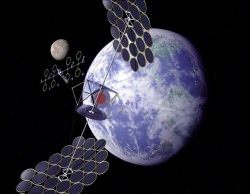
That’s an aggressive schedule. But Sage said since their plan is being driven from a commercial basis, they can run their operation differently than government agencies who don’t necessarily operate with the bottom line in mind. “Our board members and entrepreneurial group certainly have a lot of experience running commercial entities. We know what we’re doing. We’re in a market that we hope to pioneer, and everyone feels confident that we have what it takes. We certainly have the passion, vision and enthusiasm to make this happen.”
What are the biggest hurdles to overcome in this project? “If you would have asked me that question a few months ago,” Sage replied, “I would have said a combination of meeting the right people who could understand the vision and scope of what it is what we’re doing, and raising the initial financing for the demonstrator. Those hurdles, at this point, really seem to be taken care of. The more we have our technical teams talk with investors, the more people understand that we’re real and this isn’t some sort of Star Trek giggle factor. Right now, with the level of due diligence that’s been done not only on SBSP itself, but with ourselves as a commercially viable entity, we’re on the forefront of many people’s agenda in terms of how to move this forward. We see a straight path to making this a reality.”
Sage said no new technology is needed for the demonstrator, which will be a working, small prototype, but challenges do remain to move forward beyond that. “Obviously, there are technical challenges because something of this scale has never been done before. We know we can do wireless power transmission, as NASA did some pretty significant tests on this in the 1970s. We know the physics of wireless power transmission, and how everything should work from geostationary orbit.”
While the demonstrator won’t be of any scale where energy could be sold commercially, it would be a proof of concept.
“Once we’ve demonstrated that we can wirelessly beam power accurately to the ground in a safe, controlled, effective manner, and in a way that can be metered and measured,” said Sage, “we will have taken a massive step forward to prove that SBSP is a technology of the future that has the potential to really fill a gap in the world’s energy needs.”
Some have equated developing SBSP to what was accomplished with the Apollo program.
“There are so many positive spinoffs to SBSP as a game changing foundation of space commerce, that just by addressing a lot of the challenges that lay ahead, we will be blazing a trail for many other opportunities for a low earth orbit economy,” Sage added.
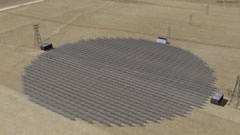
Space Energy, Inc. recently attended the World Future Energy Summit and has been overwhelmed with the response.
“We’ve had discussions with many different entities, both governmental and private, in the Middle East; Abu Dhabi, United Arab Emirates, Jordan, Dubai, many areas around Europe, and many of the world’s top investment firms. I don’t think we’re going to be short of people that will want to support us.” Sage added that in general, SBSP has strong support in Washington DC, and that SBSP recently was added to a list of technologies being studied by the Obama administration.
SBSP has ability to literally change the course of history, and impact the quality of life for people everywhere. Sage said this project is an entrepreneurs’ dream.
“I speak for our entire team here, we’re not just focused on how much money are we going to make,” Sage said. “We’re focused on the fact that this is an inevitable technology and someone is going to do it. Right now we’re the best shot. We’re also focused on the fact that, according to every scenario we’ve analyzed, the world needs space based solar power, and it needs it soon, as well as the up-scaling of just about every other source of renewable energy that we can get our hands on.”
“Space based solar power will happen whether we crack cold fusion, or whether we suddenly go to 80% efficiency on ground based solar power (currently its only at 50%),” Sage continued. “It has to happen based on the nature on what it is. With that in mind, I’ve been willing to put everything I have on the line to be able to make this work, and that was three years, ago. To see how far we’ve come in the past six to eight months has been amazing.”
“This is going to happen.”
For more information:
Space Energy, Inc.
Space Energy, Inc.’s interactive flash presentation
Video presentation on Space Based Solar Power by Mafic Studios
Citizen Science: Unmannedspaceflight.com
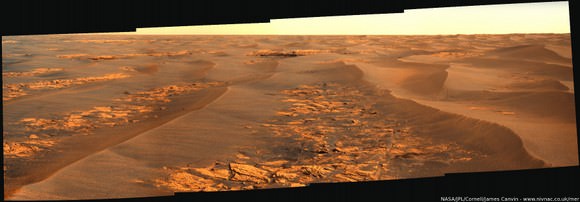
[/caption]
Note: This is the first in a series of articles about Citizen Science projects, where science is not just for professional scientists anymore!
The desire to seek out others of a like mind must be coded into our DNA. Take any subject — music, literature, art, science, math, sports, animals — you name it, and there is a group you can join to share your interest with others. Or if you can’t find a group, then you can start one and see who joins in. Doug Ellison is a great example. His online forum Unmannedspaceflight.com (UMSF) has become a place where a combination of interest in space exploration and serious “Photoshopping” has taken on new proportions. But it is also a place where the line between amateur interest and professional science is starting to blur.
Plainly put, the images, mosaics and movies created by the participants at UMSF are stunning. Whether it be a panoramic view from the top of Husband Hill on Mars, recalibrated images from the Pioneer or Voyager spacecraft to create 3D renderings or maps of the planets, or a movie of Opportunity roving on Meridiani Planum, the work being done at UMSF is a feast for the eyes. And this is all being done by amateurs who don’t receive any compensation for their painstaking handiwork, except for the joy of sharing their images with each other and the public, and perhaps converting a few space exploration naysayers along the way. They do their work using cheap, free, or even personally-created imaging software, to generate their labors of love.
How it all began
Ellison’s interest in space exploration started with the Mars Pathfinder mission in 1997, where information and images from the mission were being shared online, just as the internet was starting to boom. But when his own country, England, led the Beagle 2 Lander mission to Mars in 2003, Ellison’s interest got a little more serious. “Being a Brit, I was proud of Beagle, and wanted to talk about it with others,” said Ellison, a media producer, “but I couldn’t find any online forums discussing the mission. So I started a Yahoo group, and about 40 or 50 people descended on it, and we posted updates about the mission.” And the online updates and discussions were serious – no talk about little green men, Martians or UFOs was allowed.
The Mars Exploration Rovers were also on Ellison’s radar, as he knew they were set to land just after Beagle 2, but he admits not paying all that much attention to the rovers. However, when all contact was lost with Beagle 2 after it separated from the Mars Express orbiter, Ellison turned his attention to the rovers. The firehose of images from the rovers was almost immediate after they landed in January 2004: Principal Investigator Steve Squyres and Pancam lead Jim Bell had both decided to post all the images online, making them available for anyone with internet access virtually the instant the data were beamed back to Earth from Mars.
“I saw all these JPEG images online at the rover site, and I couldn’t help myself!” said Ellison, who had also developed an interest in image editing. “I started making mosaics and movies from the rover images. And in the same way I couldn’t find anywhere to talk about Beagle, I couldn’t find a ‘sensible’ place to talk about the rovers, and where I could discuss the images.”
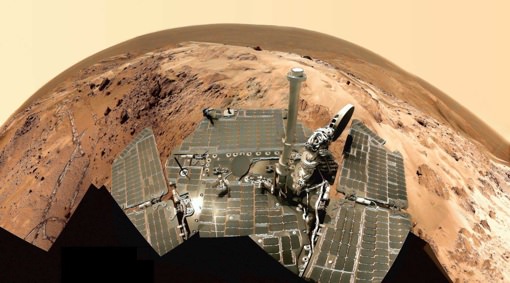
Ellison noted he hadn’t yet found the BAUT (Bad Astronomy Universe Today) forum, but he noticed that almost any website or forum where Mars was the topic, the discussion would “soon turn to anomalism, nut-jobbery, and crazy-talk, so I was determined if I couldn’t find anything I would start my own site to post my images, etc.,” he said. “And if someone came along and said something like, ‘Oh there’s a skull, and there’s cannon,’ I just wasn’t going to have it,” he said.
Ellison never advertised or “pimped” the site, and the first year things were pretty quiet, with just a few dozen people joining in who were doing their own mosaics or global maps. Then the Cassini mission came along, and those images also went straight to a publicly accessible website, so a Cassini/Saturn section was added to the forum; then a Mars orbiter section and a New Horizons section – any mission where the images were available.
“So it expanded from just being a site about the rovers to any spacecraft that was going around taking pictures,” said Ellison, “so about a year after I started the site, I re-named it unmannedspaceflight.com.”
While the site hasn’t exploded or gone completely viral, it has quietly expanded to about 1,800 active members and about 30,000 visitors a month. “It spikes when there’s something interesting happening, such as the Phoenix landing, but otherwise its fairly steady, with about 100 or so really active people contributing images, with an awful lot of people who just like to hang around and look.”
The ‘Old Days’ and Now
It used to be difficult to get images from space missions, with enthusiasts having to wait weeks or months for a print magazine or book to publish pictures taken by spacecraft. But the internet has changed all that, and in addition, attitudes among the previously exclusive science community seem to be changing as well.
“NASA really does try to make data as accessible to the public as it can,” said Emily Lakdawalla from the Planetary Society, who writes the Planetary Blog. She has been a member of UMSF since 2005, and as a planetary geologist, enjoys working with space mission images. “Anybody in the world with net access can get to all the data ever taken by nearly every NASA planetary mission,” she said. “It is sort of like discovering the back rooms of the Smithsonian collections — they display only a few percent of their artifacts. NASA captions and press-releases only a few percent of their missions’ data, but it’s all online, waiting for people to discover and use it. UMSF is a community of people who live to do just that — delve into the museum vaults, discover wonders that few people on Earth have ever seen, dust them off, restore them, and display them to public view.”
As amateurs, Lakdawalla said, they can take liberties with the data that scientists usually can’t allow themselves to. If a data dropout creates an ugly stripe across an otherwise pretty image, a scientist will usually not fudge the data to make it look better. An amateur needs to have no such constraints; they can “futz” with the images, and produce eye-catching, print-ready images out of something that would have otherwise not been very interesting to non-scientists.
“The wonderful thing about UMSF is that the community there generally takes exactly the right level of liberties with the data,” said Lakdawalla, “basically, enough fudging as is required to prevent the viewer from being distracted by artifacts of the imaging process, but little enough to let the original space data do all the talking.”
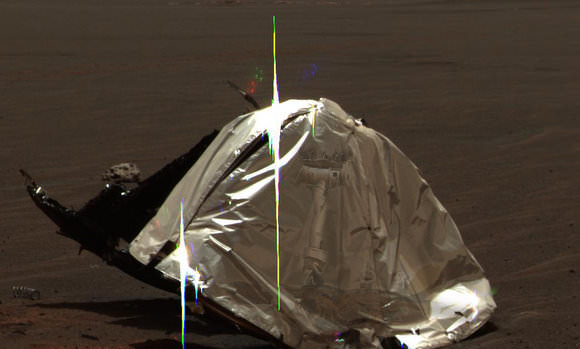
While there are many space-topic forums on the internet, UMSF is different for two very important reasons, said Stuart Atkinson, care worker for the elderly in the United Kingdom by day, who has been involved with UMSF since the old days of the Beagle discussions. “Firstly, because it has a strict – and strictly enforced – policy of not tolerating ‘off topic’ posts about such things as politics, manned spaceflight, alien babies or Bigfoots on Mars and things like that,” said Atkinson. “UMSF is, as its name suggests, a forum for discussing unmanned spaceflight – spaceprobes, basically, and if anyone comes along trying to flame, or cause trouble, or claim they’ve found a piece of wood or an alien skull in a zoomed-in-to-within-an-inch-of-its-life section of a Mars rover image then they’re in the wrong place.”
The strict “policing” of the site, performed by about a dozen or so moderators has created an environment where even scientists feel comfortable joining in on the discussions. “Planetary Scientist Ralph Lorenz has come over and talked about Titan’s dunes, and Alan Stern has joined in discussions about New Horizons, for example,” said Ellison.
Which is the other thing that makes it so special, added Atkinson. “Become a member of UMSF and you’ll find yourselves rubbing virtual shoulders with many of the men and women who actually work ON the missions… Mars Rover drivers, Deep Space Network operators, Mars geologists and climatologists, they’re all members of UMSF, and clearly love being able to take part in discussions about their work.”
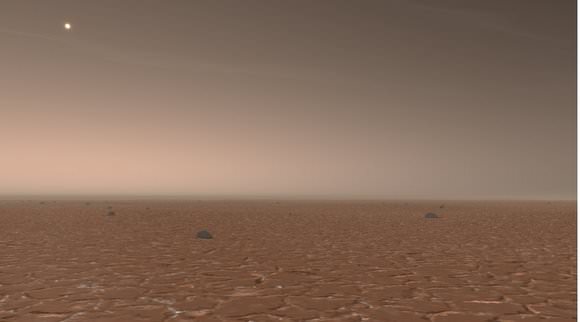
But not only have scientists joined in on discussions, they’ve come to UMSF to ask for help. Ellison said a highlight of his involvement with UMSF was when John Spencer from the New Horizons mission came to the forum asking if the members had any ideas for New Horizon’s flyby of Jupiter. “He came onto the forum and said, we’re planning the science sequence for the Jupiter flyby and do any of you have any ideas of when we should take pictures, just because they will be cool and interesting images. And he gave us the link for the tool that would show us the view from the New Horizons trajectory at a particular time, at any direction we wanted.”
Suggestions from UMSF members were put into an amalgamation of ideas from scientists and four ideas from UMSF were chosen for the flyby.
“I could not believe it, that my little forum had become an engine to come up with ideas, and these ideas got sent to a $800 million spacecraft a half a billion kilometers away,” said Ellison. “And New Horizons took this amazing picture of Europa rising up behind Jupiter. The fact that he came to us, asked us for ideas, and actually used them just was amazing.”
“New Horizons really exemplifies the best of amateurs and professionals working together,” said Lakdawalla. “All missions like to take advantage of “Kodak moments,” and the longer lived ones, particularly MER and Cassini, get the leisure to plan to take a few pictures just because they’re pretty, or significant. New Horizons wanted to do that but had a ridiculously short time between launch and Jupiter… It was a great use of amateur effort, for the right purpose — not to do science, but to do what the amateurs do best (and better than most scientists) — make pretty pictures.”
As an example of what UMSF does with images, Lakdawalla took image of Jupiter’s moons Io and Europa that was captured by New Horizons’ LORRI instrument (Long Range Reconnaissance Imager), combined it with another image taken by the MVIC (Multispectral Visible Imaging Camera) visible- and near-infrared spectrometer, to create a truly spectacular image of the pair of moons.
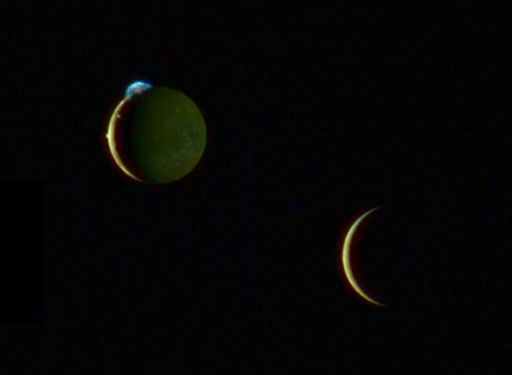
“Emily took the best data, combined them and made something better from it,” said Ellison. “I didn’t make the actual suggestion or create the actual picture but I’m very, very proud of those pictures because the people from New Horizons thought we’d come up with some sensible ideas and we did. It was an example of the amateur doing something truly spectacular.”
Ellison said starting UMSF has truly been life-changing. He has had the opportunity to meet scientists involved with the space missions, and even gave a presentation to the MER science team at Cornell University, which he said was “the highlight of my life.”
Images from UMSF have appeared on the cover of Aviaton Week, and several times on Astronomy Picture of the Day, including an incredible flyover movie of the Columbia Hills, and a great image from Opportunity of clouds and sand on Mars.
The work of another active UMSF member, James Canvin, showed up at a very special place: on the wall in the operations building for the Phoenix Mars Lander. It was visible during a visit by Sky at Night television show on BBC. “Recognition of that type, by people within the team running the mission itself is a huge honour,” said Canvin, who is a scientist for the United Kingdom’s main weather forecasting center. Canvin said image processing has become his main hobby, and countless hours have been spent writing the software to do the processing as well as producing the images themselves.

But perhaps the biggest reward of creating these “bootleg” images is the effect the images have on the general public.
“A big highlight is having my images seen (and getting positive feedback from) people who don’t normally follow spaceflight activities,” Canvin said. “I only ever post images to UMSF but occasionally I’ll see referrals coming from non-spaceflight related sites where somebody has re-posted the link with a “hey this is cool, look at this” type message. It’s nice that I have been able to help get the word out to a few people who might not have known what was going on Mars otherwise. During my time at UMSF I’ve really come to appreciate the value of working to bring the amazing sights of the solar system to as wide an audience as possible.”
Ellison also spends a lot of his time doing talks about space exploration at schools, and is working on applying for grant to do more activities with schools and even science centers. He also has plans for ways to make the tools created by the UMSF participants more accessible to more people by creating a “Wiki.” “What I want to do is extract the material and the knowledge that’s there collectively into a specialized Wiki around the things that get discussed,” said Ellison. “That will turn our sometimes idle banter into a usable, citable reference tool.” This would certainly be a tremendous resource for photography and digital imaging aficionados.
I Heart Spacecraft
UMSF is a true love affair with the images produced by our robotic spacecraft. “I was talking with (British historian) Allan Chapman,” said Ellison, “and he said this is amateur in the true sense of the word because amateur means love. And that’s true because people love doing this. We do it because it’s an adventure and it’s exploration that we can do.”
UMSF participants have created special tools to enhance the experience, like the Midnight Mars Browser written by Mike Howard. What began as a simple tool to automatically grab images when they became available, has evolved into an interactive tool that will download and sort the images, produce color composites, stereo anaglyphs and even re-project the imagery into virtual 3D space so that Pancam and Navcam imagery can be seen in context, site by site, sol by sol.
Once you start, creating your own images can also become something close to an addiction. “There’s a genuine chance for you to look at a little piece of the Mars that no one has set eyes on before,” said Ellison. “And that’s an incredibly powerful thing. The process how the pictures go online is all automated, and you think, ‘I should go to bed now, but the images will hit the web in about an hour, so I’ll stay up and wait for the pictures.’ And you make a mosaic and put it on the forum and then a hundred people can see this little bit of Mars that no one else has seen before.”
While in some people’s minds, what’s being done at UMSF brings up questions about the fair use of raw images from mission websites, it seems to point to a possible future where amateurs and scientists work together for the common good.
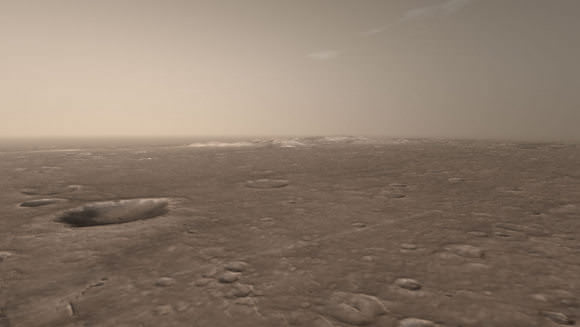
“Scott Maxwell (MER rover driver – see our three part interview with Maxwell) and I share a vision for a Mars 3.0,” said Ellison. “Mars 1.0 is when you have to wait for the press to come out with a single picture from a mission. 2.0 is roughly where we are now, where all the pictures come out and anyone can look at them. Mars 3.0 is finding a way whereby the enthusiastic public can contribute back in. I thought the New Horizons ‘Kodak moment’ was an example that it can work. It’s not sensible to hand the rover driving gloves off to amateurs or anything like that, but there has to be some sort of middle ground where there’s a type of ‘audience participation’ that can be done. The sheer numbers in the amateur community and the massively wide range of abilities they posses, they can actually make a contribution back to the missions.”
Ellison said he doesn’t know how it will eventually turn out, or even if a true amateur/professional partnership is even possible because of things like ITAR (International Traffic in Arms Regulations) and other restrictive laws that NASA and JPL must abide by.
But in the meantime, there’s much to enjoy from UMSF, even for the digitally-challenged. “Anyone can come and enjoy the pictures and watch what we’re doing,” said Ellison. “I’ve always maintained that you don’t have to register just to look at the pictures. So, come and click on the latest about Opportunity and look at the next day, and you’ll see someone will update the map, someone will make a new mosaic, and someone will make a movie: it will all happen and you can watch it. Or if you think you can wield Photoshop, and if you think you have some ideas, give us a try. As long as you don’t go into the realm of crazy, we’ll share what we know with you.”

